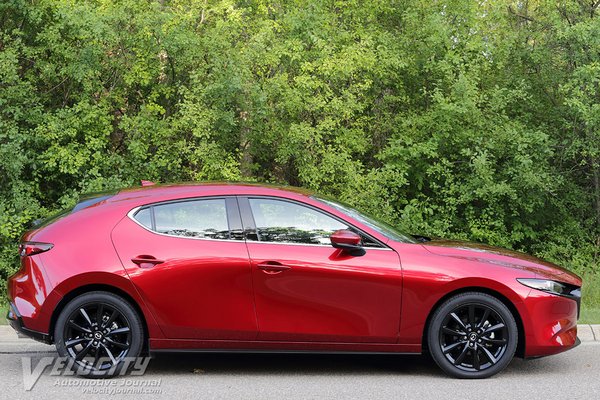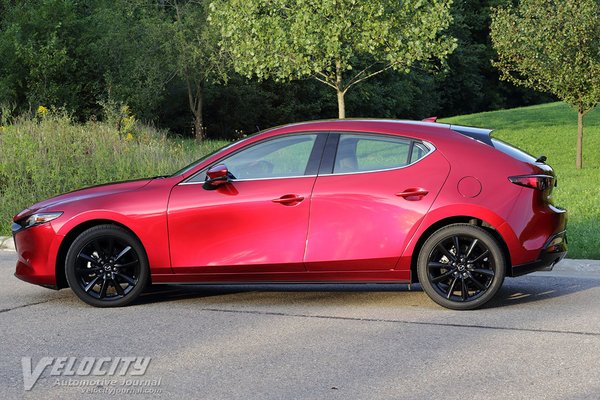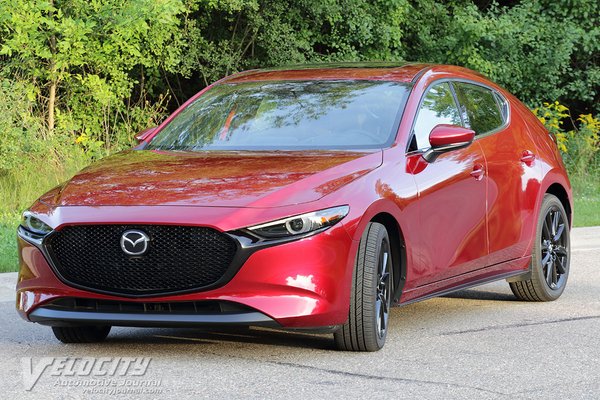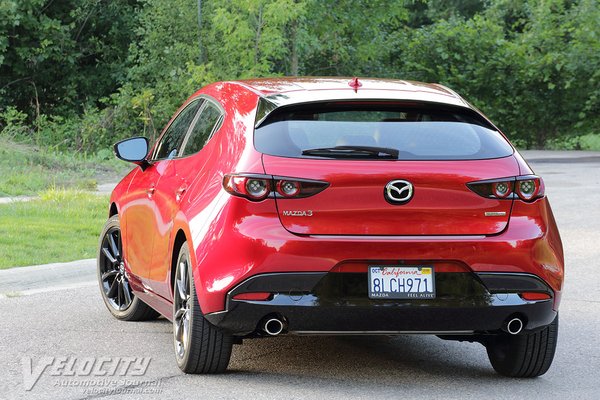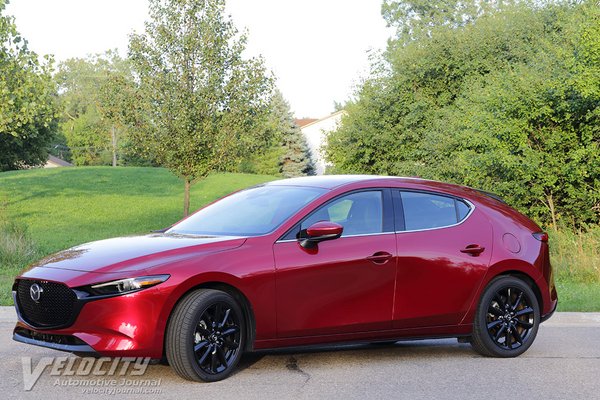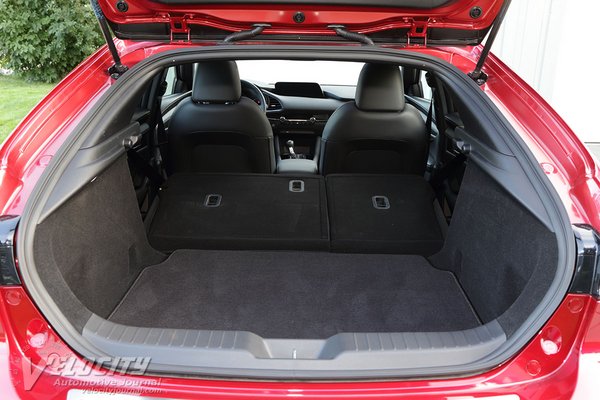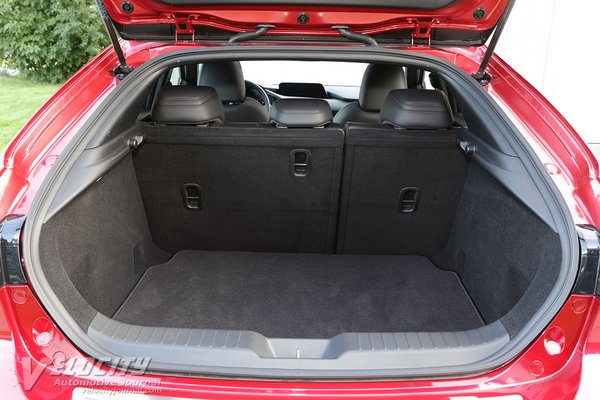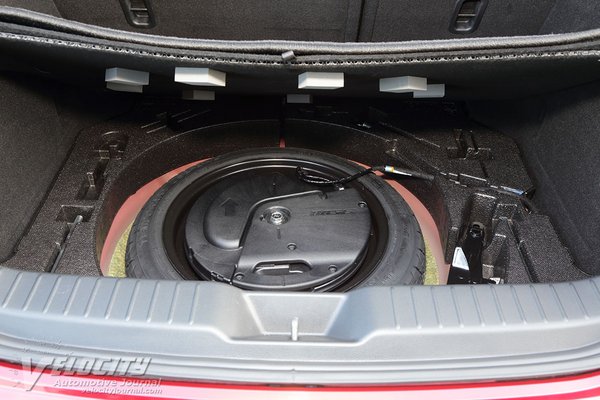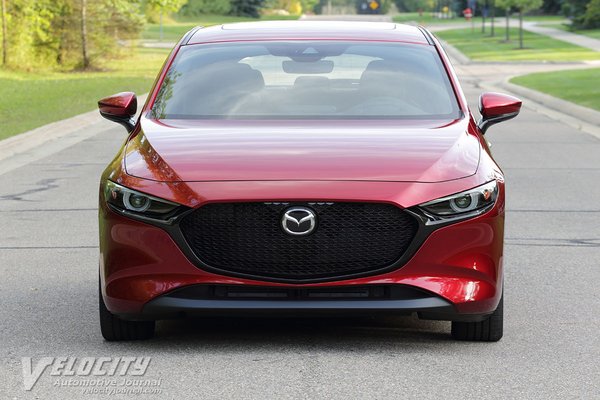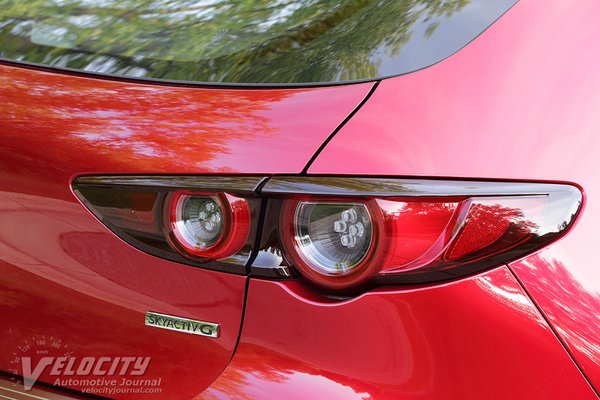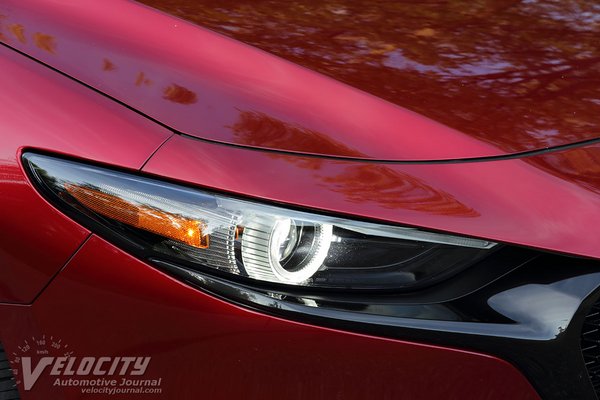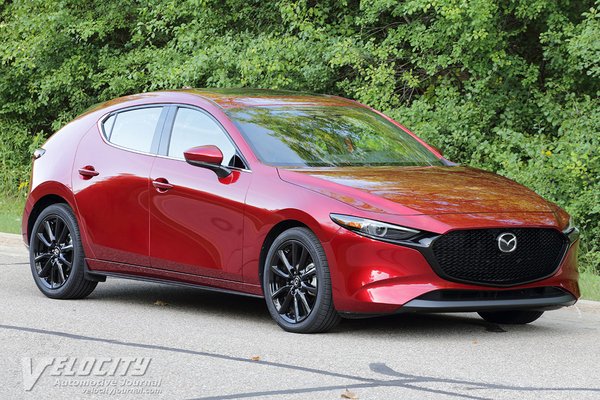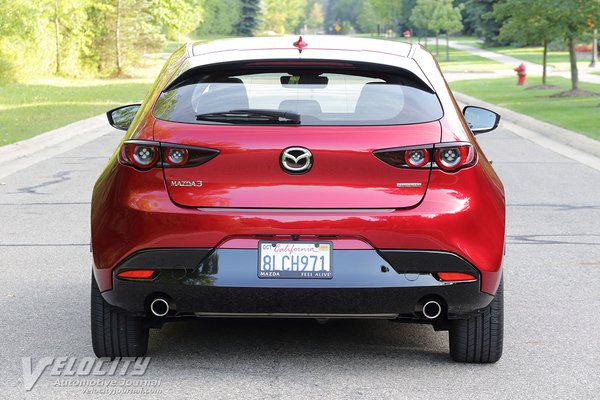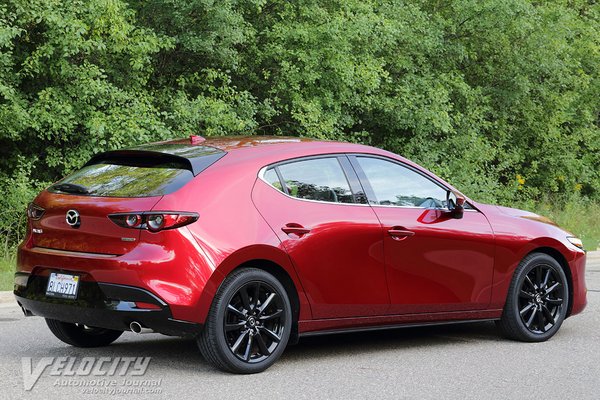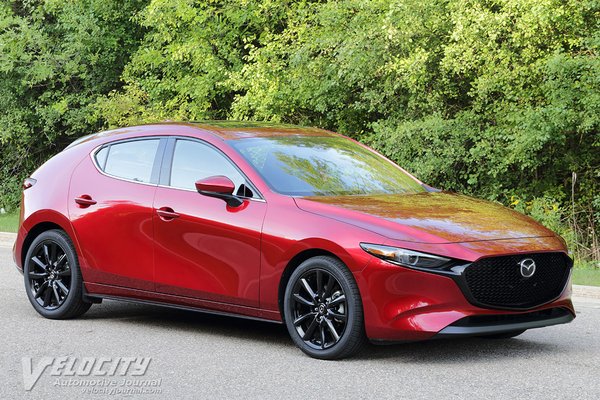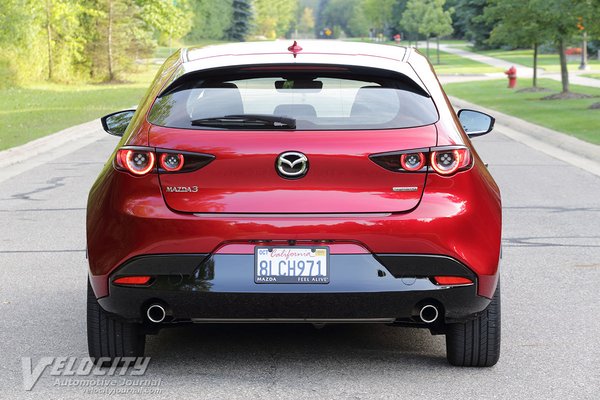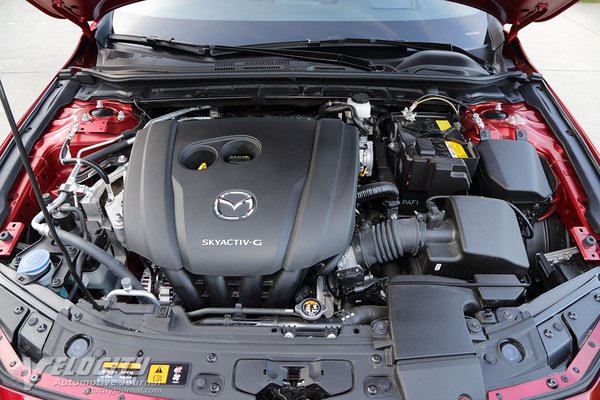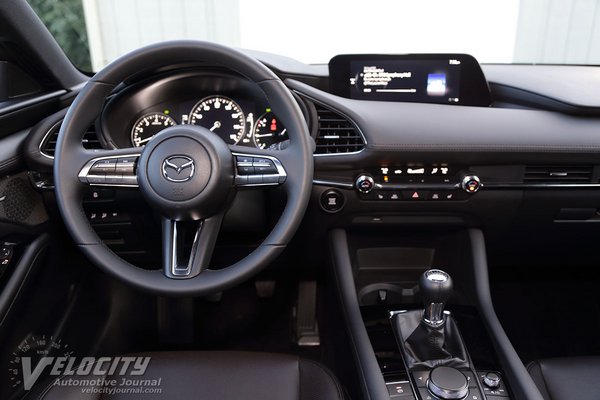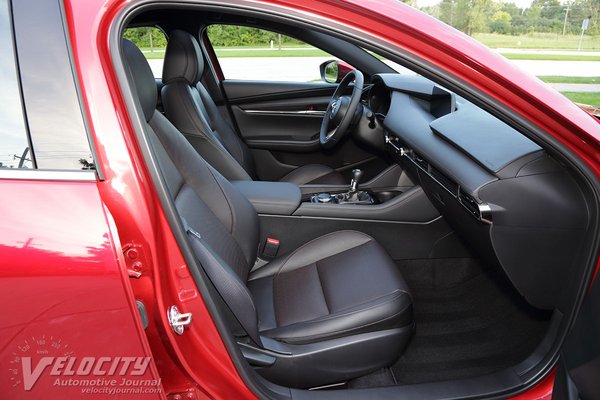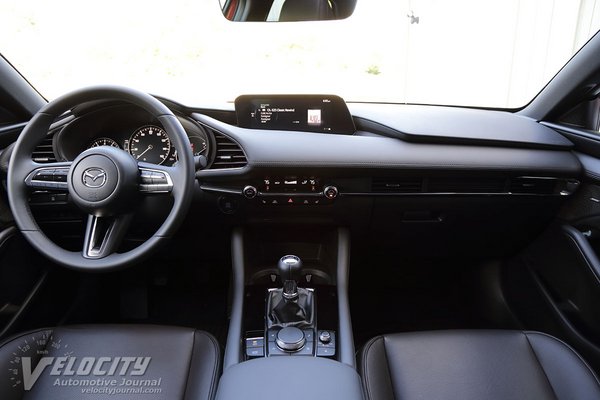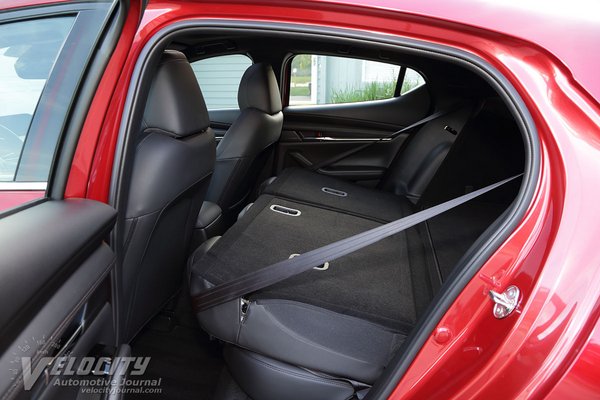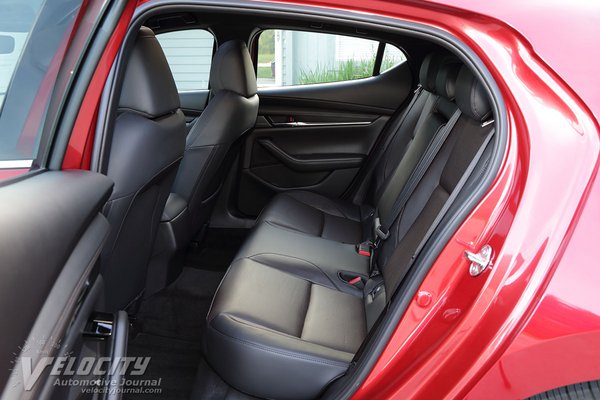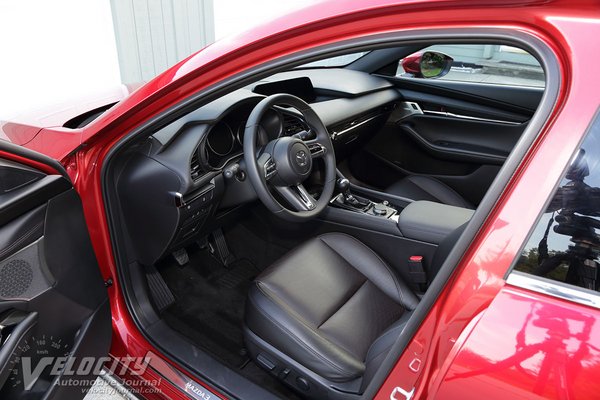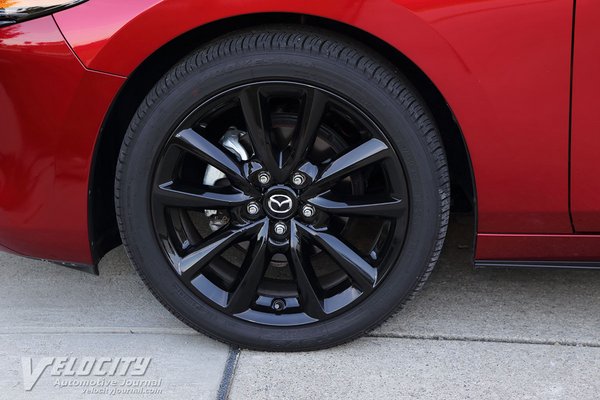2020 Mazda3 Hatchback
01/16/2021
Shahed Hussain
In the compact car segment, the Mazda3 offers premium technology unavailable from its Asian competitors. Redesigned in 2018, Mazda positioned the Mazda3 above the more popular Japanese and Korean entries. Initially launched with a 2.5L inline-4 as the sole powerplant, for 2021 Mazda brought the 2.0L inline-4 back and added a new 2.5L turbo.
Mazda sells both 4-door sedan and hatchback variants of the Mazda3, with both front-wheel drive and all-wheel drive powertrains. The base 2020 Mazda3 model is the Select ($21,500), followed by the Preferred, and the top Premium. All-wheel drive is available only on the Premium. We tested a 6-speed manual Mazda3 hatchback with the Premium package ($27,500). Additional options included cargo mat ($100), illuminated door sill trim plates ($425), soul red paint ($595), frameless auto-dim mirror ($275), navigation SD card ($450), rear bumper guard ($125), and wireless charging pad ($275). The total summed up to $30,665 including the $920 delivery fee.
Significant standard or optional equipment includes: 8.8 in. touchscreen, navigation, heated front seats, power driver's seat with lumbar support, leather-wrapped steering wheel, 18-inch diameter alloy wheels, LED headlights, LED foglights, and a 12-speaker Bose audio system. Safety technologies include a rearview camera, blind spot monitoring, active radar cruise control, lane departure warning, lane keep assist, rear cross-traffic alert. The Premium package adds leather seats, black painted alloy wheels, head-up display, adaptive front lighting, moonroof, and exterior LED accent lighting.
Mazda's 2.5L Skyactiv-G is an all-aluminum inline-4 rated at 186-bhp @ 6,000 RPM and 186 lb.-ft. @ 4,000 RPM. Direct-injection, cylinder deactivation, dual overhead cams and variable valve-timing are all designed into the Skyactiv-G. Both 6-speed manual and automatic transmissions are available, but the manual gearbox is only offered in the FWD hatchback. All AWD models are equipped with the 6-speed automatic. The manual transmission gearing is optimized for fuel economy: both fifth (0.837:1) and sixth gear (0.680:1) are overdrive, coupled to a 3.850:1 final drive ratio. According to EPA estimates, the 6-speed manual is rated at 25/35 MPG (city/hwy.). We averaged 28 MPG in mostly urban driving.
As is the norm for compact cars, the front suspension is a MacPherson strut type. Mazda replaced the independent rear suspension of the previous generation model with a torsion beam axle, coil springs and dampers. Brakes consist of vented 11.02 in. diameter front discs and 10.43 in. diameter solid rear discs with power assist; AWD models get larger 11.61 in. dia. front rotors. ABS, traction and stability control are standard. Our test vehicle had Toyo 215/45R18 Proxes A40 all-season tires mounted on 18-inch diameter alloy wheels. Steering is via an electrically assisted rack-and-pinion system. Curb weight for the FWD hatchback is 3,082 lbs.; the AWD hatchback is slightly heavier at 3,255 lbs.
The Mazda3 interior design conveys understated elegance missing from other models in its class. Matte aluminum on the dashboard, control knobs, vent bezels and door handles elevate the Mazda3 above its competition, which mostly use painted plastic trim instead. Glossy piano black door and center console panels contrast with the aluminum details. Red stitching on interior trim further enhances the impression of premium design and materials. Panel fits and overall build quality is superb.
Slide into the perforated leather driver's seat, and grab the leather-wrapped steering wheel with integrated cruise, audio, and phone controls. The instrument cluster consists of a digitally simulated analog speedometer, analog tachometer and smaller gauges for coolant temperature and fuel level. Fuel consumption and vehicle range information are shown adjacent to the speedometer. The non-touchscreen infotainment display is inset on the dash, but without affecting forward visibility. To minimize driver distraction, a center console-mounted rotary knob and surrounding smaller knobs and buttons control the audio and infotainment functions.
Comfortable, supportive seats are often missing from many affordable compact cars. We were pleased that the Mazda3's front seats have excellent support and are bolstered for a snug fit. The driver gets 6-way power adjustability and power lumbar, but the passenger seat only has 4-way manual controls. Front headroom is adequate for a sub-6 ft. driver. Rear seat passengers are rewarded with comfortable accommodations; the sculpted cushions provide above average support for the outboard occupants. Legroom and headroom are adequate assuming occupants are less than 6 ft. tall. The center seating position is only tolerable for short trips due to the hard seatback. A high beltline and small rear side windows restrict outward vision for passengers.
Even though most cars in its class are powered by 1.8 or 2.0L engines, Mazda opted to install a 2.5L inline-4 in the Mazda3. On startup, the big four is commendably quiet, especially considering its long stroke design. Torque output is adequate around 2,000 RPM, but fattens considerably near the 4,000 RPM torque peak. Horsepower builds linearly to the 6,000 RPM peak and then falls off rapidly as revs approach the 6,500 RPM redline. Although the 2.5L will rev smoothly to redline, its ample torque minimizes the need to exceed 4,000 RPM for decent acceleration.
A manual gearbox is uncommon in the compact segment, except on base models. Mazda offers its 6-speed manual in the top Premium trim, although most customers will likely opt for the automatic transmission instead. For novices, this gearbox offers an unintimidating introduction to the joy of a manual transmission. The leather-wrapped aluminum shift lever slips into each gear with low effort and positive engagement. Pedal effort is light, but the clutch only fully engages near the top of pedal travel.
Mazda engineers tuned the suspension for an agreeable balance of sporty handling and compliant ride quality. Minimal understeer and decent steering turn-in response, combined with moderate body roll proved to be an engaging mix. Braking performance was adequate, aided by a progressive pedal, but the soft spring rates resulted in noticeable dive under braking. The electrically-assisted steering is tuned for moderate effort and provides reasonable feedback of road surfaces. Cruising on the highway at 85 MPH, the Mazda3 tracked accurately with minimal steering correction on properly maintained roads. Over frost heaves and patched pavement common in Michigan, the torsion beam rear axle lacked the grip that an independent setup delivers. Considering that the Civic and Corolla both have an independent rear suspension, we were disappointed that Mazda abandoned a superior design as a cost reduction measure.
Mazda has positioned itself as a driver-oriented brand, so it's reassuring that the Mazda3 has most of the details right. The most significant issue with the Mazda3 Premium is its $30K+ pricing; the same money will buy a midsize Mazda6 Touring. We think that the less expensive Mazda3 models are probably a superior value. Mazda's inclusion of lower priced models for 2021 should put the Mazda3 on the radar for more customers.

